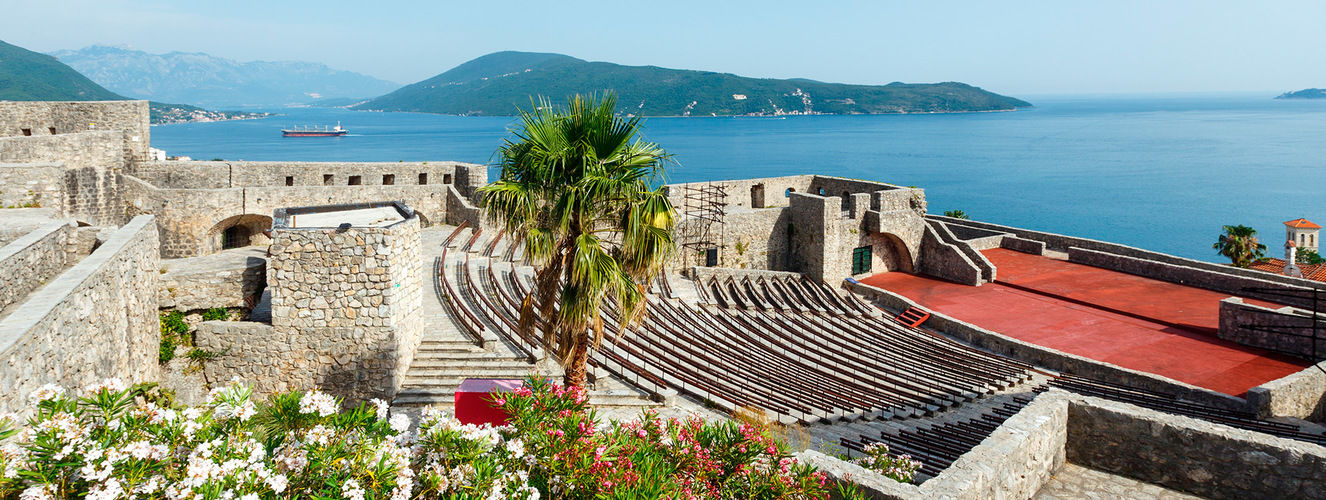



Herceg Novi is the biggest, sunniest and youngest city in the Bay of Kotor. With the first two statements you cannot argue, but the city's youth is very, very relative. Herceg Novi was founded in 1382 by the Bosnian Duke Tvrtko the First. In the distant fourteenth century, the nearby cities Kotor and Dubrovnik were already considered old residents; therefore, a new fortress in the Bay of Kotor was named Castel Nuovo - the New Fortress.
A hundred years after the Duke Tvrtko, the Duke Stepan Vukchich Kosacha descended to the Bay of Kotor from the Bosnian Mountains. Overcoming the competition with the citizens of Kotor and Dubrovnik, he founded a cloth factory (the second in Europe), thanks to which the city began to develop actively. Grateful residents decided to add the title of their wise ruler to the city's name, and now the modern double name - Herceg Novi - was obtained.
The two main symbols of the city are mimosa and "skalinade" - the stairs. By the blossom of a mimosa, the inhabitants of the entire Kotor Bay find out that spring will soon come. The inhabitants of Herceg Novi move up and down the city along the steps, training their endurance and strengthening the muscles of the legs.
The city is so built - all of its houses are on different levels, so any attempt to move around the city is an endless recounting of hundreds of stone steps by the feet. But even if you doubt your physical fitness, climbing is still worth accomplishing. The award for the spilled sweat will be the terrace of the city cafe Gradska Kafana, which offers an unparalleled view of the exit from the Bay of Kotor to the open sea.
Herceg Novi meets and sees off everyone who visits the Bay of Kotor. The city stands directly opposite a single sea entrance or exit (depending on which side to look) into the bay. From here, in the city, there are three medieval fortresses that carry out face-control - the Turkish Kanli Kula (Bloody Tower, prison for Christians), Spanish Spaniola, the Venetian Citadel. By the local tradition, all of them, if necessary, become theater stages. For example, for several years, the solemn events dedicated to the 300-year friendship between Russia and Montenegro have been held in the Bloody Tower.
In addition to historical attractions, the city is famous for its mud baths. In the suburb of Igalo, the river Sutorina flows into the sea. At the mouth of the river, a shoal was formed over the centuries on which active microorganisms created therapeutic muds, and in 1949 the Institute of Physical Medicine, Rehabilitation and Rheumatology was founded. Very close to the huge institute, on the hill behind the pine trees and cypresses, the former marshal Broz Tito's villa is hidden from the curious glances. These days it is also a mud bath, but only for the elite.
Having conquered the ups and downs of the city, you need to walk along the sea, along the wonderfully picturesque promenade and diving into the next narrow stone tunnel, imagine that along this rock trail the railway rails ran not so long ago. The Austro-Hungarians in the 19th century connected the Bay of Kotor and their continental possessions - the present Bosnia with a mile long railway. Surprisingly, but from these kilometers there were only memories and a locomotive, standing near the building of the former railway station, a modern retirement home in the Bosnian Trebinje.
There are tunnels (underground shelters for warships) not far from the only entrance to the bay. The construction time was Yugoslav, years after the Second World War, when Kotor Bay was considered as a strategically important object.
Two small tunnels are not very deep, they go to the peninsula for a hundred meters each, torpedo and rocket boats were hiding in them and two submarines could be hidden in a two-hundred-meter-long Rose tunnel and not only to hide, but also to arm and repair.
Rose is interesting to look in spite of what then becomes sad. A grandiose concrete structure demonstrating the power of the former Yugoslavia has been abandoned and forgotten. Several times it became a venue for the festival of electronic music, and now here, jumping into the water from a height of fifteen meters above the entrance to the tunnel, the desperate youth competes in courage.